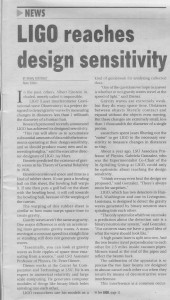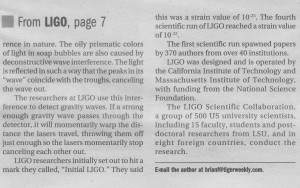Back in 2005 when I was an undergraduate in Physics at LSU, I tried to cover LIGO for the weekly campus newspaper I freelanced for, Tiger Weekly. You may have heard of LIGO in recent days with the discovery of gravity waves. Well, I knew what they were trying to do over a decade ago and how cool and monumental a thing it would be. I just had trouble convincing others of this fact.
The problem was things were tumultuous at the paper with a new editor and an attempt to adjust the content to appeal to a broader readership. And the way things worked was a writer would propose a story idea, the editor(s) would give it the green light or not, and then the writer would go to work on the story for the next issue. Well, this process did not guarantee the story would ever be published and the writer paid.
I was considered the news guy at the time and was often tasked with some of the more difficult subjects and stories we covered, especially the technical ones. This was not necessarily a good role to have to play at a paper more focused on drug use, student’s sex lives, sports, selling beer and bar ads, and covering whatever the controversial flavor of the month was, but I played it. I enjoyed it, usually. I actually learned about LIGO while covering some other stories coming out of LSU’s Center for Computation for Computation and Technology (CCT), like the hiring of a former NASA JPL computer scientist, Dr. Thomas Sterling, that went by the nickname “tron.” It was cool stuff.
Well, LIGO fascinated me when I learned about it for a few reasons. First, I love reading stuff about black holes and gravity and I got to speak with people using supercomputers to model the collision of spiraling neutron stars. Nerd heaven.
Second, LIGO is based in Livingston, Louisiana, which is about an hour from LSU’s campus, and it seemed shocking that such research was being done in the state. It was like learning they were testing a warp drive down the road. And the folks at the CCT were always nice and cooperative and more than happy to discuss their work with me
And third (this is completely geeky), my sci-fi theory for faster than light travel revolves around gravity waves.
My thinking goes (and I was told this was the case) that gravity waves behave like regular waves, meaning they can interfere with one another. I’ll just link to the wiki article on the phenomena to save time. So if gravity waves can interfere with another another like regular waves then you can do one of two interesting things: neutralize a wave or cause it to resonate. Just like how a singer can shatter a champagne glass by producing the right tone, we might be able to do something similar to space-time itself without needing a pair of black holes. That’s what’s great about resonance patterns and standing waves. They let you keep contributing tiny bits of energy to a wave to keep increasing its amplitude. It’s like pushing someone on a swing to get them higher and higher. So, let’s do the same with gravity and significantly smaller masses to see what happens.
I even emailed Michio Kaku once asking if this was possible, but never got a response. I’ll put it in a wildly popular book one day and then he won’t be able to ignore me any longer! Geek rant (fail) over.
So, I brought the story to the attention of the editor and dove right into setting up interviews and doing research. After many hours of work, I produced a 900 words feature story on the facility and sent it to the editor for review. She rejected it on the basis it was too technical.
I was really upset with this at the time and it even irks me a little now, given the recent breakthrough. I had been so excited about the story and put a lot of time and effort into it, as well as taking up other people’s time. And well, I didn’t get paid. It might have only been like $25 or $30. I can’t remember for certain, but it was my money. But looking back now with the benefit of experience and reading the original story (which I pulled off a laptop older than the story), the editor wasn’t completely wrong. The story was in need of some dumbing down.
Fortunately, I wasn’t finished with LIGO. It took another year and a new editor (managing editor), as well as developing my own abilities and reputation as a writer. We got one of those overly complicated press releases about the facility “reaching design sensitivity,” and the managing editor at the time (who kept things running through Katrina), Samantha Morgan, brought it to my attention. Well, I jumped at the chance to do another LIGO story and be paid for it this time. Samantha, who remains a good friend and has moved onto much bigger and better things, was a lot more open-minded about story ideas, thankfully. And I felt that was to the benefit of the paper. So, when I got in touch with old contacts, reused some stuff from the original story I wrote, and updated things with the news in the press release, she published the story. It took a year, but I got it done.
I wish I could link to the story. Once upon a time, I could have, but the original website that hosted all of my freelance stories from those days died when the paper re-branded itself, DIG. It’s kind of sad and I wish the publisher would post those old stories in an archive format or something, assuming copies of them still exist.
Nevertheless, I like to hold onto things that might become important later, so here’s a scan from one of my old copies of the original issue of Tiger Weekly, March 22-28, 2006. You can click on them to enlarge them for the sake of readability. And yes, there is at least one typo. I think I have a typo curse or something about my writing style screws with people’s brains. Even when my stuff goes through professional editors, its weird how artifacts escape notice. And I’m not faulting Samantha. Tiger Weekly had a shoestring (if your shoestrings are made of dental floss) budget and reliable copy editors were hard to come by. The one or two we did have time to time were usually just overwhelmed trying to edit a dozen stories on a Sunday afternoon.
And for comparison sake, here’s the original 2005 version of the story. It’s more general, more technical, was never published, and never passed before the eyes of a copy editor. But I’m still a little proud of it. It’s cool being able to say that, yes, I covered what LIGO was up to ten years before the big boys even deigned to notice it. I bet the relevant Wikipedia entries got slammed with traffic when word got out.



